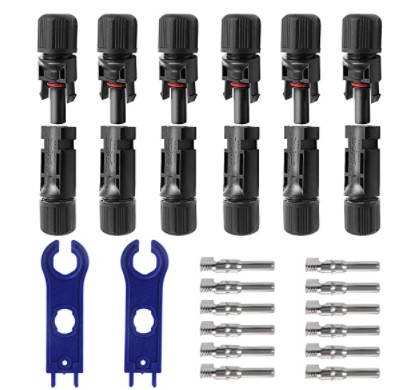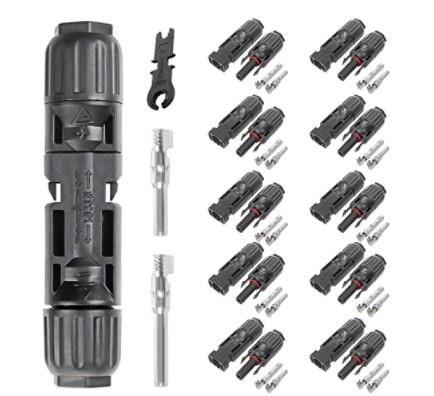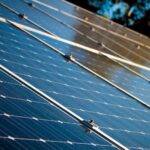Are you on the lookout for the best solar panel connector money can buy? We hear you. When you get into the green lifestyle and start investing in solar panels, you learn about critical components, such as solar panel connectors. What are these, and what types are there? To help you in the right direction, we’ll tell you about solar panel connectors types and more.
If you wish to go solar or upgrade an existing system, you ought to know that the connectors are essential to get your energy system working correctly. If you feel intimidated by solar panels and all the wiring it goes with them, connectors can make wiring your solar array much simpler and faster.
While it can be challenging to find a suitable solar panel connector for your needs, especially when you are new to the solar world, it is also not impossible. If you search for a solar panel connector and wish to know more about it, continue reading and get inspired by the following options.
Solar Panel Connectors Types FAQ
What connectors do solar panels use?
Modern solar modules tend to use MC4 connectors because they make wiring your solar array much simpler and faster. The connectors come in male and female types, designed to snap together.
Are solar panel connectors Universal?
MC4 connectors are single-contact electrical connectors commonly used for connecting solar panels. The MC4 and compatible products are universal in today’s solar market, equipping almost all solar panels produced since about 2011.
What are the many Solar Panel Connectors Types?
Connectors are of various types, the major ones being MC3, MC4, PV, and Tyco Solarlok. Similarly, they come in many shapes, such as T-Joint, U-Joint, X-Joint, or Y-Joint. The most common type of solar connector is the MC4 connector.
Are all solar panel connections the same?
When solar panels are wired in series, the panels’ voltage adds together, but the amperage remains the same. So, if you connect two solar panels with a rated voltage of 40 volts and a rated amperage of 5 amps in series, the series voltage would be 80 volts, while the amperage would remain at five amps.
What is the difference between MC3 and MC4 connectors?
MC3 connectors have mainly been superseded by MC4 connectors due to support being withdrawn by the National Electrical Code for solar applications. The MC3 connector does not incorporate a positive locking mechanism and can become disconnected while the solar panels produce electricity, causing dangerous arcing.
How to replace a solar panel connector?
- After carefully removing the old connector, for example, by cutting it off with a cable cutter, remove about ½ inch of isolation from the cable’s tip.
- A typical connector has four main elements. Unscrew the cap to disassemble it.
- Then put the wire through the cap. Do the same with the cable gland.
- Next goes the pin: secure it in the appropriate slot of the crimping tool, then feed the exposed end of the cable into the cavity. Softly holding it in place, press the tool to crimp the pin to the wire.
- Now join the main component with the rest of the connector by screwing them together. They should meet in the middle.
- The last step will be to tighten the connection. Lightly pull on the connector to see if it is secure on the cable’s end.
What to think about when choosing solar panel connectors?
- Size: Each type of solar connector has specific max-rated amps that you can send through it, which is related to the capacity of the solar panels, inverter, solar charge controller, and of course, the wire. You can search for the recommended wire gauge for each connector in the manufacturer datasheet, but this is not regularly an issue for residential solar installations.
- Connector Wiring: Solar setups are wired with MC4 elements through DC positive (+) and DC negative (-) wires from each module. The typical positive lead is the male connector, and the negative is the female though this is not always the case. A series connection is established when the mechanisms are joined via connecting the positive lead to the negative charge of two systems. This increases circuit voltage. When a series circuit is wired, the maximum power current remains consistent.
- Voltage: Parallel wiring occurs when the positive and negative terminals are connected using multibranch components or a PV combiner box for establishing a link between more than two panels. This enhances the current at maximum power while at the same time keeping the voltage uniform.
- Trimming: At times, MC4 units are cut in half to plug into both solar panel leads. In a typical installation, the connector must provide enough wire to reach the destination. In systems where a combiner box is employed, the length of the cut must enable the cable to terminate in the box. Then, stripping the insulation away from the cut ends and terminating them to bus bars or circuit breakers completes the connection.
- Applications: Solar connectors function in applications designed to fix solar modules and cables for industrial and residential use.
If you are wondering about Solar Panel Inverter Cost, then you should read our article on that topic; hopefully, you’ll find it useful.
Solar Panel Connectors Types
MC3
The MC3 connector was the most popular solar panel connector in past years, being an excellent and straightforward option manufactured by Multi-Contact. This connector has a 3 mm single-contact cylindrical plug for the male connectors and a socket shell design for the female connectors.
MC4
The MC4 connector was designed by Multi-Contact as well. The connector features a single-contact cylindrical plug perfectly fitting the socket shell working as the female connector. The MC4 also has a safety class II system, UV protection, an impedance below 0.5 Ω, and an IP68 Ingress Protection (IP) index. Being such a simple yet secure connector, the MC4 makes solar installations very easy.
Helios H4
The Helios H4 is another popular type of solar panel connector manufactured by Amphenol. This connector has a design compatible with the MC4, making it easier for homeowners to install one or the other without worrying about compatibility.
SolarLok
The SolarLok is also known as the Tyco connector for wires, which was a very popular connector around the year 2000. This connector is manufactured by Tyco and can still be seen in old installations. The Tyco SolarLok connector for solar cables was used for connecting one module to the next one in a series or parallel structure, depending on the required configuration for the solar array.
Radox
The Radox connectors are a quality option manufactured by Huber + Suhner that features a 15-year warranty. These connectors use copper-beryllium contacts made with a lamella design to ensure the correct current passage through the wires.
Solar Panel Connectors Types You can Buy
YXGOOD Solar Connectors MC4 Male/Female
The waterproof ring ensures that water and dust will not enter the connector during extended outdoor use.
Connection; putting the male and female connectors facing each other and pushing in. Separation;
pressing the two sides of the built-in lock and pulling the male and female connectors.
The included spanners are fully adaptable to the connectors and quickly tighten the connectors. Simple, quick, and safe effective assembly.

Features:
- CMA
- IP67 Waterproof
- DC 1000V
BeideLt Mc-4 Solar Panel Cable Connectors
PV connectors are designed to connect solar panels arrays, usually in parallel applications.
The adaptor is also designed to connect photovoltaic solar systems with high mechanical requirements and extreme weather conditions.
The shell is made of pro insulating &hard plastic material with high rigidity, high heat resistance, fire resistance, wear resistance, pollution resistance, excellent aging resistance, and anti-ultraviolet ray ability, and can resist severe weather such as heavy rain, snowstorm, or heat for a long time.

Features:
- Waterproof
- Anti-Oxidation Connector
- Highest PPO+PA Material


